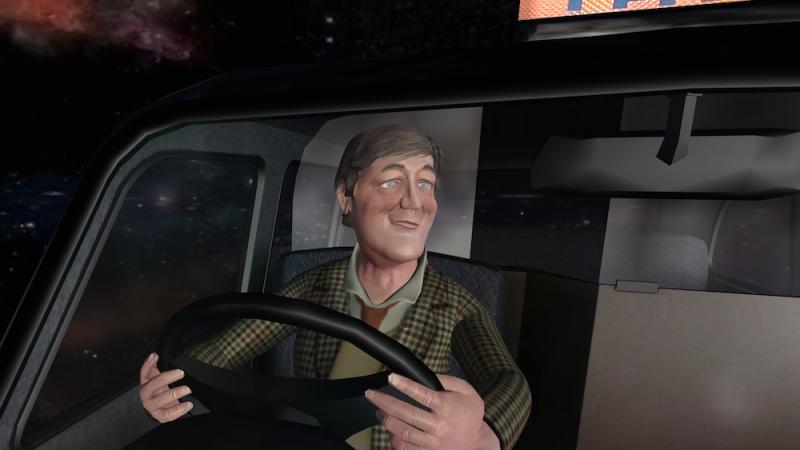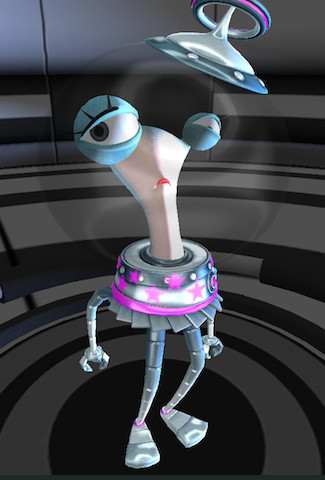We Made It: The Headcaster App | reviews, news & interviews
We Made It: The Headcaster App
We Made It: The Headcaster App
Chris Chapman explains the genesis of his animated character app

Is it possible for a mobile phone app to combine functionality with the highest standards of design and craftsmanship? Chris Chapman, the creator of the Headcaster app, says it is. He brings a sculptor’s eye and puppeteer’s sense of movement to the creation of a fun platform for people to communicate with friends and the wider world through animated characters.
Chapman (pictured below) explains how the app works for the user. “You arrive in the app and you’re presented with a host of characters – you can choose to be anything from a talking set of teeth and eyebrows, to pumpkin-head, to a political character in the satire section. You tap on them and speak, and the moment you play it back you voice is automatically lip-synced through the character. The character‘s got what we call ambient moves: blinking, breathing, looking side to side, and so on.” Then you press send and it goes off to your social media of choice, or can be added to the library on the app itself.
 What is it about the technology that makes this all possible? Chapman says, “We have now reached a tummy point of comfort with people. We can render fast enough on the phone a character that you believe in it. Below a certain level your tummy goes ‘Uurgh’, above a certain level your tummy goes ‘Aah!’”
What is it about the technology that makes this all possible? Chapman says, “We have now reached a tummy point of comfort with people. We can render fast enough on the phone a character that you believe in it. Below a certain level your tummy goes ‘Uurgh’, above a certain level your tummy goes ‘Aah!’”
Essentially, he thinks, Headcaster is a tool: “We’re putting an actor on a stage and he’s there waiting for someone to talk through them. We define what the character is and how it moves, but you talk through it, you play music, you jump up and down with it, you do stuff to take it creatively in different directions.”
As with all tools, it is only as good as its user and, browsing through the animated videos posted on the app, the design (for which the app is responsible) is much more impressive than the content (provided by users). Not everyone has something interesting to say, regardless of the quality of the graphics. More interestingly, Headcaster has a number of celebrity users, including Stephen Fry. (I would have liked to see a Stephen Fry “headcast”, but none is available on the app or website.)
I ask about Fry’s involvement. He is well-known as an early adopter of tech and it is easy to see how Headcaster appealed to him. Chapman explains that “back in the very early days Stephen couldn’t be at Douglas Adams’ virtual 60th birthday party, so we said we would build him and have him on the screen. So he pre-recorded a speech and, during the event, up came Stephen Fry on the screen. And afterwards I got back in touch and said, ‘We’re going to take this on as an app, are you interested?’ He was interested and invested a little, and we built him out in the early versions.”
Famous people using the device as an avatar is a potentially fruitful avenue. Chapman tells me that a number of comedians are interested in recreating themselves within Headcaster, and I can see its appeal as a means of sharing material online more vividly than through a tweet and less labour-intensively than making a live action video. There are also outlets for the technology in mainstream television, including producing material for BT Sport.
 Chapman himself has a varied and fascinating backstory. He started out as a sculptor, from which he moved into special effects, going from there to “a plum job on Spitting Image very early on, heading up the engineering workshop side, so there was a mix of creative skills and tech”. Another career swerve saw him working in medical product design and then a business producing “smart fabrics – interfaces for controlling clothes you wear”. Chapman’s vision for Headcaster combines these disparate strands: “I’m a third creative, a third tech, a third business.”
Chapman himself has a varied and fascinating backstory. He started out as a sculptor, from which he moved into special effects, going from there to “a plum job on Spitting Image very early on, heading up the engineering workshop side, so there was a mix of creative skills and tech”. Another career swerve saw him working in medical product design and then a business producing “smart fabrics – interfaces for controlling clothes you wear”. Chapman’s vision for Headcaster combines these disparate strands: “I’m a third creative, a third tech, a third business.”
The app is itself technically dazzling and has extraordinary features like the characters’ eyes following you if you turn your phone, but feels slightly like a technology that is yet to find its most profitable form, either financially and creatively. It is currently a quirky toy but could become a common feature of television and social media.
Read other articles in We Made It, our series on craft in partnership with Bruichladdich
Explore topics
Share this article
The future of Arts Journalism
You can stop theartsdesk.com closing!
We urgently need financing to survive. Our fundraising drive has thus far raised £49,000 but we need to reach £100,000 or we will be forced to close. Please contribute here: https://gofund.me/c3f6033d
And if you can forward this information to anyone who might assist, we’d be grateful.

Subscribe to theartsdesk.com
Thank you for continuing to read our work on theartsdesk.com. For unlimited access to every article in its entirety, including our archive of more than 15,000 pieces, we're asking for £5 per month or £40 per year. We feel it's a very good deal, and hope you do too.
To take a subscription now simply click here.
And if you're looking for that extra gift for a friend or family member, why not treat them to a theartsdesk.com gift subscription?
more We made it
 We Made It: Guitar Maker Brian Cohen
The incredible one-man string band
We Made It: Guitar Maker Brian Cohen
The incredible one-man string band
 We Made It: Basket-maker Lois Walpole
Weaving works of art from 'ghost gear' and the detritus of consumerism
We Made It: Basket-maker Lois Walpole
Weaving works of art from 'ghost gear' and the detritus of consumerism
 We Made It: Horn Maker Tom Fisher
Bespoke horns, handcrafted in a Derbyshire cellar
We Made It: Horn Maker Tom Fisher
Bespoke horns, handcrafted in a Derbyshire cellar
 We Made It: Stufish Entertainment Architects
From U2 and Madonna to Chinese theatre and the Martian Fighting Machine
We Made It: Stufish Entertainment Architects
From U2 and Madonna to Chinese theatre and the Martian Fighting Machine
 We Made It: 'Carol' Costume Designer Sandy Powell
How she brought a melange of styles to Todd Haynes's sublime period romance
We Made It: 'Carol' Costume Designer Sandy Powell
How she brought a melange of styles to Todd Haynes's sublime period romance
 We Made It: Stuntwoman Tracy Caudle
Forget Evel Knievel: a well-crafted stunt is more about precision than daring
We Made It: Stuntwoman Tracy Caudle
Forget Evel Knievel: a well-crafted stunt is more about precision than daring
 We Made It: 'The Revenant' Production Designer Jack Fisk
How he stunningly recreated the authentic American frontier of 1823
We Made It: 'The Revenant' Production Designer Jack Fisk
How he stunningly recreated the authentic American frontier of 1823
 We Made It: Double Bass Maker Laurence Dixon
Love at first sight, a six-day week and the satisfaction of a job well done
We Made It: Double Bass Maker Laurence Dixon
Love at first sight, a six-day week and the satisfaction of a job well done
 We Made It: The Electric Recording Company
Pete Hutchison's quest for musical perfection on vinyl
We Made It: The Electric Recording Company
Pete Hutchison's quest for musical perfection on vinyl
 We Made It: Watchmaker Roger W Smith
The world-leading horologist keeping British watchmaking alive, crafting exquisite timepieces by hand
We Made It: Watchmaker Roger W Smith
The world-leading horologist keeping British watchmaking alive, crafting exquisite timepieces by hand
 We Made It: Concert hall acoustics
The RSNO have a new concert hall. The lead acoustician explains why it sounds so good
We Made It: Concert hall acoustics
The RSNO have a new concert hall. The lead acoustician explains why it sounds so good
 We Made It: The Headcaster App
Chris Chapman explains the genesis of his animated character app
We Made It: The Headcaster App
Chris Chapman explains the genesis of his animated character app

Add comment